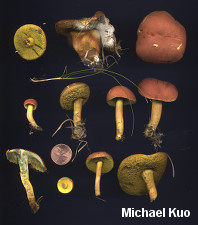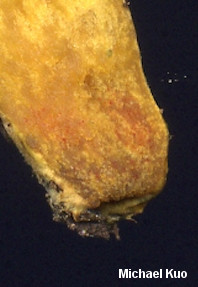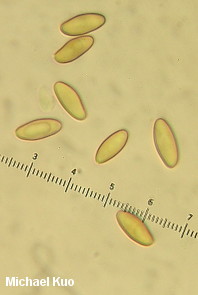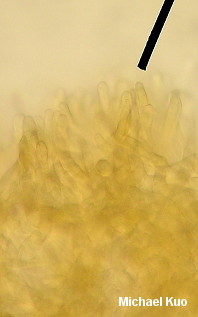| Major Groups > Boletes > Red-Capped, Blue Staining > Boletus campestris |

|
Boletus campestris [ Basidiomycota > Boletales > Boletaceae > Boletus . . . ] by Michael Kuo If you're an enthusiastic mushroom identifier and you have lots of time on your hands, try picking a little, red-capped bolete with a yellow, blue-staining pore surface and sitting down to figure out what you've picked. Boletus campestris can be virtually indistinguishable from Boletus harrisonii, Xerocomellus rubellus, and several other less frequently encountered mushrooms (including Boletellus pseudochrysenteroides and small forms of the usually larger Boletus bicolor). However, if you have fresh specimens in which the flesh at the base of the stem has not begun to discolor and deteriorate, you will be able to narrow down your identification competitors significantly; Boletus campestris is one of only two of these species (as far as I know) featuring tiny, bright red to carrot orange dots in the flesh at the base of the stem. The other species is Xerocomellus rubellus, which is more rare (possibly limited to sites where European trees have been planted as ornamentals) and features brighter red colors, along with prominent red points on the surface of the fresh stem and (definitively), under the microscope, a very different pileipellis. Using the generic concepts of Šutara (2008), Boletus campestris should probably be placed in Xerocomus, since the genus Xerocomellus is limited to species with a palisadoderm, and Boletus, in the strict sense, contains a group of very different species centered around Boletus edulis. Description: Ecology: Mycorrhizal with hardwoods (especially oaks); growing alone, scattered, or gregariously, in woods or, frequently, at their edges, in parks and gardens; summer and fall; probably widely distributed east of the Rocky Mountains. The illustrated and described collections are from Illinois. Cap: 2-6 cm; convex, becoming broadly convex in age; dry; bald or finely velvety; the surface not cracking up at maturity, or doing so only finely, near the margin; brick red to dull red, sometimes with a yellowish margin; fading to orangish red. Pore Surface: Becoming depressed at the stem; yellow at first, becoming dull olive yellow; bruising promptly blue; with 1-3 angular pores per mm; tubes to about 1 cm deep. Stem: 4-7 cm long; 0.5-1 cm thick; more or less equal, or very slightly tapered to the base; yellow above, reddish below; bald or very finely dotted with red pruina or punctae; not reticulate; basal mycelium pale yellow. Flesh: Pale yellow; staining blue (sometimes erratically or faintly) when sliced; flesh in stem base with numerous tiny, bright red to carrot orange dots. Odor and Taste: Not distinctive. Chemical Reactions: Ammonia grayish on cap surface; grayish on flesh. KOH dull orange on cap surface; dull orangish on flesh. Spore Print: Olive brown. Microscopic Features: Spores 11-13 x 4-5 µ; subfusiform; smooth; yellow in KOH; brownish to ochraceous in Melzer's. Hymenial cystidia lageniform; to about 50 x 12.5 µ. Pileipellis a trichoderm of tubular, cylindric elements 5-10 µ wide; terminal cells tubular, with rounded or subacute apices; bright yellow in KOH; brownish to ochraceous in Melzer's. REFERENCES: Smith & Thiers, 1971. (Smith, Smith & Weber, 1981; Weber & Smith, 1985; Arora, 1986; Phillips, 1991/2005; Lincoff, 1992; Both, 1993; Horn, Kay & Abel, 1993; Metzler & Metzler, 1992; Bessette, Roody & Bessette, 2000; Kuo & Methven, 2014.) Herb. Kuo 06269510, 08240211, 08240502. This site contains no information about the edibility or toxicity of mushrooms. |
© MushroomExpert.Com |
|
Cite this page as: Kuo, M. (2014, December). Boletus campestris. Retrieved from the MushroomExpert.Com Web site: http://www.mushroomexpert.com/boletus_campestris.html |



